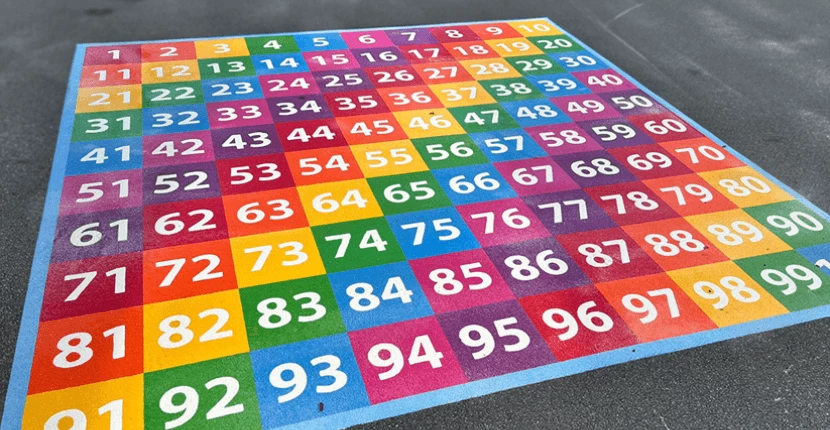
Maths and Numeracy Playground Markings in Herefordshire
Get In TouchSchool Playground Markings transforms outdoor spaces into dynamic learning environments with innovative maths and numeracy playground markings in Herefordshire.
Our vibrant, durable designs help students develop key mathematical skills through active, engaging play.
From number grids and multiplication trails to geometry patterns and time-telling clocks, we create custom solutions that align with your curriculum and inspire a love for maths.
Perfect for schools and nurseries, our markings encourage kinaesthetic learning while promoting physical activity. Contact us today to design a playground that combines fun and education, tailored to your needs!
What are Maths and Numeracy Playground Markings?
Maths and numeracy playground markings are educational designs applied to outdoor surfaces to support the teaching and practice of mathematical concepts.
These playground markings include visual elements such as number grids, geometric shapes, coordinate systems, and hopscotch patterns that encourage interactive learning.
Mathematic playground markings in Herefordshire provide a kinaesthetic approach to maths, allowing children to physically engage with numbers and concepts while reinforcing their understanding through play.
Playground markings are typically made from durable, weather-resistant materials, ensuring they are long-lasting and suitable for frequent use.
What Types of Maths and Numeracy Playground Markings are Available?
Our interactive thermoplastic maths and numeracy playground markings in Herefordshire transform outdoor spaces into dynamic, hands-on learning hubs.
Designed to spark curiosity and build foundational maths skills, each installation is crafted from durable, weather-resistant materials, ensuring longevity in busy play environments.
From primary school playgrounds to community parks, these innovative markings engage children in active learning through games and puzzles that reinforce key concepts in arithmetic, geometry, and logical reasoning.
Number Line Markings: Customisable sequences that reinforce counting skills and number recognition, ideal for practising addition and subtraction, and building number fluency.
Arithmetic Hopscotch: A modern twist on a classic game, integrating mental calculation challenges with physical movement to promote numeracy and coordination.
Geometric Shape Trails: Vibrant, educational pathways showcasing various geometric shapes, enhancing spatial awareness and a practical understanding of geometry.
Maths Puzzle Paths: Engaging outdoor puzzles designed to develop problem-solving and critical thinking skills through stimulating mathematical challenges.
Counting Courses: Dynamic routes that support sequential learning and pattern recognition, helping to establish a strong foundation in early maths concepts.
How much do Thermoplastic Maths and Numeracy Playground Markings Cost?
The average cost of thermoplastic maths and numberacy playground markings is £500 - £1,500.
The costs for installing maths playground markings in Herefordshire varies depending on the designs' size, complexity, and customisation.
If you would like a more accurate quote, contact a member of our team today.
What are the Benefits of Maths and Numeracy Playground Markings?
Our maths and numeracy thermoplastic playground markings in Herefordshire transform outdoor spaces into engaging, interactive learning environments. These durable installations not only enhance educational outcomes but also promote physical activity and cognitive development. Key benefits include:
Enhanced Numeracy Skills: Reinforces counting, arithmetic, and geometry, building a strong mathematical foundation.
Interactive Learning Environment: Integrates play with education, stimulating problem-solving, critical thinking, and logical reasoning.
Cognitive Development: Promotes spatial awareness and analytical skills through dynamic, hands-on puzzles and challenges.
Outdoor Engagement: Encourages active learning and physical exercise in a vibrant, stimulating setting.
Durable & Low Maintenance: Crafted from high-quality thermoplastic, ensuring weather resistance and long-lasting performance.
What Age Groups are Suitable for Maths Playground Markings?
Maths playground markings in Herefordshire are suitable for children aged 3–12 years, with activities tailored to different developmental stages.
Early years students benefit from basic number recognition and counting games, while older children can engage in activities involving multiplication, fractions, or coordinate grids.
How do Playground Markings Make Maths Learning More Engaging?
Playground markings make maths learning more engaging by transforming abstract concepts into interactive, physical activities that capture children’s attention.
Thermoplastic markings in Herefordshire combine vibrant colours, familiar shapes, and structured games to make learning enjoyable. By integrating movement, such as jumping on number grids or running through patterns, children engage their bodies and minds simultaneously, promoting kinaesthetic learning.
Markings encourage social interaction through group challenges, fostering teamwork and communication while practising maths skills.
The outdoor environment provides a refreshing change from classroom settings, increasing focus and enthusiasm. These elements create a fun, dynamic way to explore maths concepts, making learning memorable and effective.
How do Schools Incorporate Numeracy Markings into Curriculum Activities?
Schools incorporate numeracy markings into curriculum activities by aligning outdoor games with maths lessons to reinforce key concepts.
Teachers use these educational markings during structured sessions, such as practicing arithmetic on number grids or exploring geometry with shape patterns.
Thermoplastic playground markings are integrated into group activities, where students collaborate to solve problems or participate in timed challenges, promoting teamwork and numeracy skills.
Numeracy markings in Herefordshire serve as tools for independent learning during breaks, allowing students to practice counting, multiplication, or fractions at their own pace.
Schools enhance engagement and retention of mathematical concepts by combining curriculum objectives with active, hands-on play.
Are Maths Playground Markings Suitable for Special Education Needs?
Maths playground markings are suitable for students with special educational needs (SEN) as they provide an adaptable, multisensory approach to learning.
The visual and tactile nature of the markings helps children grasp abstract mathematical concepts, such as numbers or shapes, in a concrete and accessible way.
Activities can be modified to match individual learning levels, allowing students to progress at their own pace.
Including kinaesthetic elements, such as jumping on number grids or stepping through patterns, supports motor skill development while reinforcing numeracy skills.
Customisable designs can incorporate sensory-friendly features and clear visual cues, ensuring inclusivity and engagement for diverse learning needs.
Other Services We Offer
We cover Herefordshire
